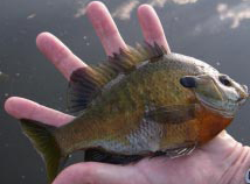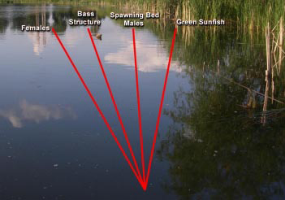Pond Fishing for Sunfish
A couple of years ago my oldest son did two great things great things for Father’s Day. He took me to his “secret” farm pond to fish and on the way home had me stop so he could buy us some beer. Thanks E for the beer, but more importantly for reintroducing me to the joys of fishing for sunfish.
 I’m using sunfish rather than bluegill since many farm ponds and small lakes generally contain a couple of different species. Besides bluegill many have green sunfish, long ear sunfish or even hybrids. What ever the species, the fishing techniques are generally the same.
I’m using sunfish rather than bluegill since many farm ponds and small lakes generally contain a couple of different species. Besides bluegill many have green sunfish, long ear sunfish or even hybrids. What ever the species, the fishing techniques are generally the same.
Sunfish fishing starts to really pick up as the water temperatures move into the low 70’s. That signals the start of the spawning season. As spawning begins, males move into shallow waters – 2 to 5 feet – and build nests. A firm sand bottom is preferred but even soft mud will do. The males tend to congregate in one area and “fan” out their plate sized nests. These spawning beds can be 10 feet wide and 30 or 40 feet long. While the males are building the nests the females wait out from the shallows to where the depth drops off. Once the nests are ready the females move in to spawn. After spawning the females return to their pre-spawning areas. The males remain and actively and aggressively guard the nest. Spawning will continue for most of the summer. Once you find the locations you have found the fish.
 The waters with the biggest sunfish generally have good populations of bass. Not necessarily big bass, but a lot in the 10 to 12 inch range. These bass feed on the young sunfish and keep the pond from developing a stunted population of sunfish.
The waters with the biggest sunfish generally have good populations of bass. Not necessarily big bass, but a lot in the 10 to 12 inch range. These bass feed on the young sunfish and keep the pond from developing a stunted population of sunfish.
If you can’t see the tell-tail foot prints of a spawning bed, the best way to find fish is to walk or wade parallel to the bank casting to the edge and working out toward the middle with successive casts. If you prefer a float tub, move toward the edge until you find the ‘drop off” and start working casts closer to the shore.
If the pond contains green sunfish they will most often be found right next to cattails or other emerging vegetation. Green sunfish have a “bass like” shape and feed ravenously on the bluegill fry that move into the vegetation for shelter and protection.
 The next casts out are the ones that will pay the benefits, both in terms of a beautiful catch and the number of fish. Once you find out how far out the spawning bed is the fun begins. Besides being hungry, males are very aggressive in guarding their nest. No matter if the strikes come from hunger or aggression, they do take your offerings.
The next casts out are the ones that will pay the benefits, both in terms of a beautiful catch and the number of fish. Once you find out how far out the spawning bed is the fun begins. Besides being hungry, males are very aggressive in guarding their nest. No matter if the strikes come from hunger or aggression, they do take your offerings.
If there is any visible holding structure don’t pass it up. These locations will very often be the best chance for a bigger bass. They tend to hang around the structure and prey on the smaller spawners or the newly hatched fry.
Finally, the casts furthest out from the shore will produce the females which are staging to move into or back into the spawning bed. Keep cast progressively further out toward the middle until number of fish that rise drops off.
The fly of choice is something that will float well and stand up to catching a lot of fish!
Small poppers are the stand by. But any dry fly will work. For durability it is hard to beat a fly like a Rat Faced McDougal or an irresistible. Most sunfish have a relatively small mouth. Even so they can swallow a size 10 popper. The problem is removing the fly to release them. A pair of hemostats is critical, as is pressing down the barb.
The best strategy after each cast is to allow your fly/popper to rest undisturbed on the surface for a few seconds. When your fly lands, especially in the spawning bed area, several fish will move close and hang suspended just below the fly looking up at it. After resting peacefully, a slight twitch will bring one or more of the fish up to inhale your offering. Miss or catch, cast right back to the same area. More than likely one of the other fish will take your offering.
For the casts close to the emergent vegetation and any structure give the fly a bit more action. In fact make the popper earn its keep by creating a slash and a wake. That will solicit some attention for the fish eaters.